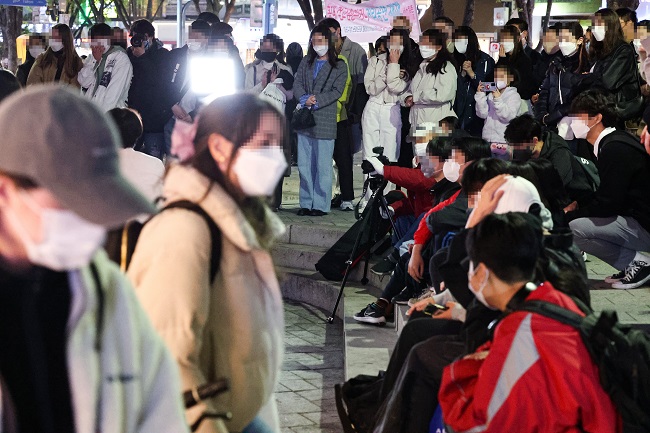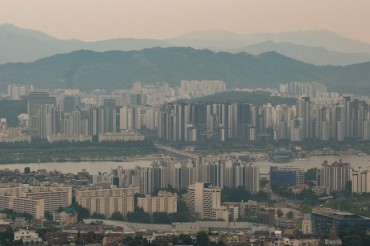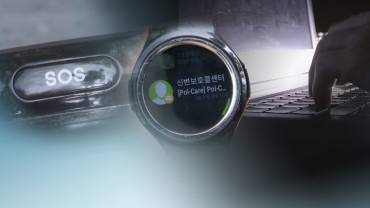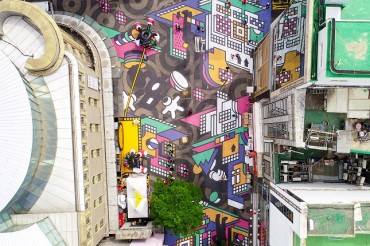
People watch a street performance in the popular hangout district of Hongdae in western Seoul on April 14, 2022. (Yonhap)
SEOUL, April 15 (Korea Bizwire) — South Korea will fully lift the seven-day mandatory quarantine for COVID-19 patients late next month, the public health agency said Friday, as it prepares a post-pandemic regime amid the waning virus.
The new road map unveiled by the government also includes a downgrade of the COVID-19 infectious disease level by one notch to the second-highest level out of the four-tier system, allowing patients to receive treatment at local clinics and hospitals like an endemic disease, the Korea Disease Control and Prevention Agency (KDCA) said.
“We have come to fully understand the characteristics of omicron and equip ourselves with effective weapons like vaccines and treatment,” the government headquarters on the COVID-19 response said in a release.
“We will push for a return to the general medical system where people can get the diagnosis and treatment at local clinics and hospitals and enjoy everyday life even if they get infected with COVID-19,” it said.
The government also announced it will lift all COVID-19 social distancing rules, except the mask mandate, starting next week, in the first big step toward post-pandemic days since the outbreak of the novel virus two years ago.
The post-omicron scheme came as South Korea has seen a marked fall in daily COVID-19 cases after the virus curve peaked at more than 620,000 in mid-March.
On Friday, South Korea reported 125,846 new COVID-19 infections.
Health officials predict that the new daily case numbers could hover between the range of 50,000-100,000 for quite some time.
Under the new road map, COVID-19 will be downgraded to Class 2 from Class 1, on March 25.
But there will be a tentative four-week “transition period” to allow the new system to sink in. Once that period ends, all medical systems will return to operating as normal.
The protracted COVID-19-driven overload has taken its toll on the country’s general medical system, and the government has been trying to improve the situation.
The downgrade of the classification level means the authorities no longer have to oblige patients to quarantine and make reports to the health agency on their health status.
It also removes the requirement for at-home treatment.
Travelers entering South Korea will only need to submit one negative polymerase chain reaction (PCR) test result on the first day of their arrival. They still need to get a PCR test 48 hours before departure.
Starting Monday, the midnight business hour curfew for restaurants, cafes and other small businesses will be completely lifted.
The same will apply to the 10-person cap on the size of private gatherings, Prime Minister Kim Boo-kyum said. There will be no limit in the size of large gatherings like an event or demonstration.
The mask mandate will stay for now as the government will carefully monitor the virus situation over the next two weeks, Kim said.
South Korea first introduced social distancing measures in March 2020. At one point, the restrictions were tightened to only allow two people to meet at night and only allow takeout at cafes.

Travelers line up to check in for boarding near a domestic departure gate of Gimpo International Airport in western Seoul on April 15, 2022. (Yonhap)
On international travel, all inbound vaccinated people will be exempt from the seven-day quarantine.
The government is also considering gradually expanding the visa-free entry for countries that do not have the mutual visa waiver program with South Korea.
It also plans to revive the use of international flights by 50 percent within this year by lifting the limit on the number of arrivals per hour at Incheon International Airport, west of Seoul, and resuming international flights at regional airports.
On Friday, the total COVID-19 caseload reached 16,104,869, according to the KDCA. The death toll from COVID-19 came to 20,616, up 264 from Thursday. The fatality rate stood at 0.13 percent.
The number of critically ill patients reached 999, up 37 from the previous day.
As of 9 p.m. Friday, the country had reported 104,915 new cases, down 18,712 from the same time the previous day, according to health authorities and provincial governments.
Daily cases are counted until midnight and announced the following morning.
As of midnight Thursday, 44.52 million, or 86.8 percent out of the population, had been fully vaccinated with two shots, and 32.97 million had received the first booster shots, representing 64.3 percent, the KDCA said.
The number of those who got their second booster shots came to 356,651, accounting for 0.7 percent.
(Yonhap)






